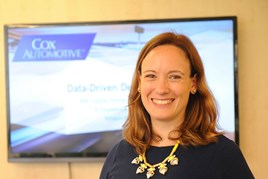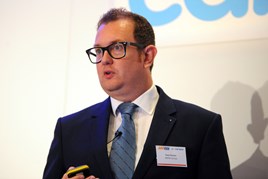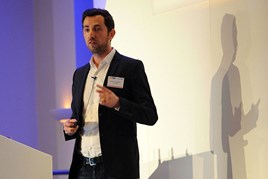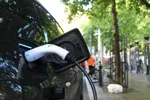By Tim Rose, Jeremy Bennett and Debbie Kirlew
The car-buying process has successfully been “turned on its head” through allowing the customer to take control and through streamlining a sales process that has changed little since the motor car was invented more than 100 years ago, delegates at AM’s latest Digital Dealer conference heard.
Simon Dixon founded Rockar, the motor retailer specialising in shopping centre stores, using experience he gained launching digital dealer Jamjar in 2000. However, he also drew on the eight years he spent as a dealer customer after selling the business in 2004, an experience that “horrified” him.
“I saw that the gap between what was happening digitally in the rest of retail and in the car business was getting wider and wider,” he said.
Dixon’s response was to create Rockar: “I couldn’t just change a small part of the traditional business model. I had to reinvent it.”
Within three weeks of opening its first store, Rockar was the largest Hyundai dealer in the country by retail sales and it is still consistently in the top three. The store at Bluewater
Shopping Centre has had 266,000 people visit since opening in November 2014 and its Westfield branch has had 197,000 since December 2015.
The rest of the Hyundai network of 158 dealers, Dixon said, see up to 155,000 customers in a year. A total of 421,000 customer journeys through the sales process have been recorded in the two stores. Some 52 million people have walked past the two stores, “the equivalent of one TV advert played over and over again”.
He said the underlying factor in Rockar’s success was empowering the customer. Car retailing, Dixon believes, is currently focused on the dealer having control.
“At the heart of what we needed to do was reverse this dynamic – put the customer in control of knowledge-gathering.”
There are three key areas where this has been enabled, he said. The first is technology. Dixon explained how the search process begins not with what car someone wants, but with a consumer’s buying power, i.e. the deposit available or the preferred payment structure.
Technology brings price transparency. Rockar’s prices are set at a senior level. Its IT system stores details of 2,400 Hyundai model variations and pricing information can be displayed for each for PCP, hire purchase or a cash price.
“There is no salesman going back and forth between a customer and the business manager,” said Dixon.
Test drives can be booked in the same way as you can book a table at a restaurant, specific to date and time. Order tracking is also transparent – the customer can see their car’s journey as easily as they can track an Amazon delivery.
The second element is the stores. Rockar cited statistics that said nearly 75% of customers under 30 will find a traditional dealership intimidating.
“The industry is building bigger dealerships, but fewer people are going to them. It was a no-brainer – we should put our stores where people are going, where they are comfortable and in a retail frame of mind,” said Dixon.
To make them inviting, Rockar stores do not have a front door. When a customer comes in, the staff, known as angels, do not approach them, “so they move further into the shop”. At the centre of each store is a digital hub, known as “the creation zone”, with tablets where a customer can go through the transaction process, with or without help.
Screens on the walls promote the car brand, present the proposition and display transparent prices.
Rockar presents the national average price first, “not-high deposit, low-mileage with the price going up from that point, which is the industry’s typical approach”.
The third element is Rockar’s people. As prices are set centrally, traditional sales skills are not required.
“We choose our teams on personality, communication skills and retention of knowledge,” said Dixon.
There are no targets in each store and none of the staff at this level know the business’s financial objectives. Staff are measured on “angel engagements” or customer interactions. Angels introduce themselves, not by asking ‘can I help you?’, but ‘how are you?’.
The continuous gathering of data means Dixon knows 30% of what models Rockar will sell the next week and even the day it will sell them, he said. Other snapshots he presented were: 58% of orders are from women; 60% of transactions are online outside the store and 48% are outside normal dealership opening hours.
Dixon said traditional dealers could learn from Rockar: “Simplify your business and make it transparent. Consider how many processes and how many people are involved when someone wants to buy a car? Then make pricing obvious, particularly transaction prices. Interrogate your website. There’s likely to be an offer on your homepage. But does it take four or five clicks to get to the detail?”
Leo Nelson, marketing director at car supermarket group CarShop, echoed Dixon’s call for simplification and better understanding of how consumers shop.
CarShop has been implementing digital technologies for several years, and wants the experiences on its website and in its stores to fuse together in a natural way.
Data and analytics help to drive decisions, and to respond to customer changes and market conditions, said Nelson.
For example, last year, the number of visits to CarShop’s website from mobile devices outstripped those from desktop, so it has replaced its responsive website, built in 2013, with a new site designed to be mobile-first.
As part of its “evolve or die” ethos, CarShop asked its customers what they want from a website and analysed their behaviours when they are in the market. The analysis showed CarShop how the website was used, that speed of loading was important, and the investment was needed in imaging, turntables and features.
It takes CarShop about 12 minutes to take 100 photos of a car. Useful features enable visitors to save vehicles to a consideration list, or to return to previously viewed vehicles, and to view helpful videos explaining the services they can use online or in-store.
“One of the big challenges car retailers face is understanding how consumers are using our websites to facilitate a purchase. Unlike electronic goods or fashion, where the decision to purchase is followed quickly by the transaction on the website, we don’t always have that luxury,” he said. Nevertheless, CarShop does allow people to pay a deposit and have the car delivered.
Web conversion
Awareness, consideration, intent and decision are the four stages in the path to purchase that dealer group marketers need to consider when creating and enhancing their websites. Martin Dew, head of digital marketing at Autoweb, said dealers must optimise for each stage. Websites are often too focused on one or two of those stages, and do not optimise areas of the website to move visitors well from one stage to another.
 The dealer website needs good calls to action and buttons to make it clear what the visitor needs to do, but the details on the website still need to convince them to do it.
The dealer website needs good calls to action and buttons to make it clear what the visitor needs to do, but the details on the website still need to convince them to do it.
Tactics to encourage the transitions include:
■ Pages enticing the visitor to look at its offers
■ Pages to configure a new car and get a specific quote
■ Tools entitled ‘what is your car worth’ rather than just ‘part-exchanges’
■ Details about the business and staff, which helps earn customers’ trust
■ A voucher that pops up after the visitor spends a certain period looking at a used car page.
“Generally you’ll want to show someone who has already been on the website or performed an action a different message the second time,” Dew said.
Feature finance
Almost two thirds (65%) of the top 200 dealer groups have “fully interactive finance offers on their websites” and the day when consumers “self-serve” funding solutions online is dawning, said James Tew, chief executive of iVendi.
 “Dealers have now switched on to this,” said Tew. “They recognise they can offer finance online and they are not going to lose money.”
“Dealers have now switched on to this,” said Tew. “They recognise they can offer finance online and they are not going to lose money.”
However, 35% of dealer groups still do not offer the facility despite consumers increasingly opting to search online by monthly payment. Figures from PwC show almost three quarters (74%) of buyers have arranged funding before visiting a showroom.
While online applications may be in their infancy – the first ‘end-to-end’ finance transaction was completed online in 2015 – and conversion rates are about 2%, Tew said it is a gradual upward trend.
He believes providing personalised online quotes to consumers and enabling them to “self-serve”
the finance process also solves potential problems meeting FCA requirements. He predicts the creation of a secure self-service online car finance portal for consumers as the model evolves.
Build trust
The motor retail industry has a trust issue, according to Auto Trader. Research found only 7% claimed to trust car dealers. Their most common descriptions of the car-buying journey were “interesting”, “a necessity” and “time-consuming”, although third in the list was “enjoyable”.
 Chris Penny, Auto Trader’s franchise brand director, said: “The perception is far, far worse than reality, which shows, as an industry, we’re improving things. Pre-purchase, 43% think they will get pressured. Post-purchase, only 21% said they did. It’s still far too high, but there is a difference between what they expect and what they actually get.”
Chris Penny, Auto Trader’s franchise brand director, said: “The perception is far, far worse than reality, which shows, as an industry, we’re improving things. Pre-purchase, 43% think they will get pressured. Post-purchase, only 21% said they did. It’s still far too high, but there is a difference between what they expect and what they actually get.”
The industry needs to work harder on changing those perceptions, including online, said Penny. Some consumers get turned off by a dealer because it is too hard to find the information they require, or the process is too stressful.
“Progressive digital retailers use that perception to steal consumers from under your noses just by doing things really well. Being just as good as everyone else in the industry is no longer acceptable,” he said.
It also applies when they visit the showroom. They want simple things done well, as 71% of consumers turn up intending to test drive or buy that day.
“If you’re not getting the fundamentals of retail correct, you can put all the 3D imagery into your business you want, but it won’t make a blind bit of difference, because you’re not creating trustworthiness and a sense of confidence,” said Penny.
Market insights
Allison Nau, head of data solutions at Cox Automotive, revealed a new source of market insight aimed at enhancing a dealer’s decision-making process.
 As parent of Manheim and Motors, Cox Automotive has put together insight based on information gathered from Manheim’s auction data and Motors.co.uk’s consumer activity that would, she said, enhance decision-making based on “intuition, intelligence, predictions and optimisation (maximising a particular objective given a set of constraints)” to run a dealer business more efficiently.
As parent of Manheim and Motors, Cox Automotive has put together insight based on information gathered from Manheim’s auction data and Motors.co.uk’s consumer activity that would, she said, enhance decision-making based on “intuition, intelligence, predictions and optimisation (maximising a particular objective given a set of constraints)” to run a dealer business more efficiently.
She said these four factors will be commonly used to answer questions Cox data seeks to answer for dealers: the deal you need to give a customer in order to sell a car, part-exchange values, how long should a car take to sell, what a vehicle is worth wholesale, what do I need to do to beat the competition?
Retail online
“Ease of transaction is very much a buzz phrase within BMW,” said Paul Kester, BMW Retail Online project manager at BMW Group.
 BMW Retail Online launched in November 2015 and achieves triple-digit new car sales every month, said Kester, all fulfilled through the dealer network. Via the website, a prospective buyer can configure their chosen car, be offered a similar one from stock or proceed with a factory order, get a guide price for their part-exchange, receive a finance approval from BMW Financial Services within 90 seconds and be passed on to their chosen dealer to convert the sale.
BMW Retail Online launched in November 2015 and achieves triple-digit new car sales every month, said Kester, all fulfilled through the dealer network. Via the website, a prospective buyer can configure their chosen car, be offered a similar one from stock or proceed with a factory order, get a guide price for their part-exchange, receive a finance approval from BMW Financial Services within 90 seconds and be passed on to their chosen dealer to convert the sale.
“What we want to be able to do is to move all of the touchpoints that retailers have day-to-day and potentially simulate them in duplicate within a digital world.
“That means as a customer if I’mhappy to go in and do the majority of my transaction in the showroom as I have always done , but if I would find it more comfortable to ask my laptop for a discount I can do that,” said Kester.
Research has shown that 90% of women would not go into a BMW dealership without a man by their side, and the carmaker is not proud of that, particularly given forecasts that by 2025, 60% of the world’s wealth will be in women’s hands.
“We’re in the wrong place at this time, we need a quick transition with our retailers to understand the opportunities that exist. We believe online is one of those ways we need to change, to embrace new audiences.”
Kester said consumers perceive more control online. Analysis of its first year in operation show online buyers are choosing a more expensive BMW in the first place, and are spending more on options.
He said Retail Online is not to replace physical dealerships. “The investment in showrooms at BMW is as important as it has ever been – customers need that as a comfort blanket to make sure they’re making the right decision on their purchase.”
3d visualisation
Three-dimensional visualisation of a car and real-time configuration is a way of winning back consumers’ interest in the showroom experience, Francois de Bodinat, chief marketing officer of software company ZeroLight, told delegates.
 There have been 15 million fewer visits to dealerships last year compared with the previous year. Of a survey of 4,000 new car buyers, only 17% said they had a good
There have been 15 million fewer visits to dealerships last year compared with the previous year. Of a survey of 4,000 new car buyers, only 17% said they had a good
experience, said de Bodinat. The reasons consumers are choosing not to visit include the lack of confidence and the dealership being in the wrong location.
De Bodinat said one solution is the personalisation of products provided through digital visualisation.
“Every car can be different from the next in some way, so when you go to a dealership you want to see the car you aim to buy: the spec, the trim, the equipment, the wheels,” he said. “But, typically a dealer will point to a car in the showroom or in brochure and tell you ‘this is your car, only in a different colour, spec etc’.”
However, a dealership with three-dimensional assets enables a customer to see exactly the car they want. The benefit to the dealer is that it does away with the requirement to stock sufficient numbers of cars to present the model range adequately – which in turn dictates the dealership’s location.
“By moving the dealerships into shopping centres or downtown areas of a city, the chances of people seeing and then experiencing your brand will increase. You are where the people are.”
De Bodinat gave examples of the impact of real time 3D visualisation.
At Audi City stores, customers choose and configure a car on a tablet, with an image that appears on a wall screen. The dealership has only two cars on display, but, via visualisation, customers can experience Audi’s 70 models and millions of customisable variations.
The result has been a 70% increase in year-on-year sales and the average transaction price at Audi City in London is £8,000 higher than Audi centres elsewhere in the UK.
Online reputation
Online customer reviews have become a key influencer in buying decisions. But how well do you know the reputation your business has and are you in control of it?
The question was posed by Charlie Roberts, enterprise business manager at online reputation management company Reputation.com.
According to the Harvard Business Review, each star in a Google rating, up to a maximum of five, can mean a difference of 5%-9% in revenue.
Some 92% of internet users read product reviews, 89% of people say they influence their buying decisions and 79% trust online reviews as much as they do an appraisal made by word-of-mouth.
“Reputation drives revenue,” Roberts said. “Reputation stands between your marketing spend and new customers.”
Reviews are “front and centre” of searches and on social media, he said. For example, Inchcape Retail, a Reputation.com client, has 2,500 ‘points of presence’ to manage, taking into account reputation measures for more than 120 locations on sites from Google and Facebook, to Yelp and Yell.com.
“You should address your reputation on all these sites, even where you only have one or two comments,” said Roberts.
Carwow
People buying a TV wouldn’t expect to trek to three different stores to compare three different brands, but the new car industry still demands this, said Carwow sales director John Miele. “People don’t want that, they want everything in one place.”
 Brands have to cater well for different types of consumers, those who simply want to buy a product as quickly and easily as possible, those who want to spend time comparing features and prices, and those who want to touch and see the products in the metal.
Brands have to cater well for different types of consumers, those who simply want to buy a product as quickly and easily as possible, those who want to spend time comparing features and prices, and those who want to touch and see the products in the metal.
Apple, for example, sells products all at the same price on Amazon, on its own website, in its own stores and in third-party stores – “it caters for everything”, said Miele.















Login to comment
Comments
No comments have been made yet.